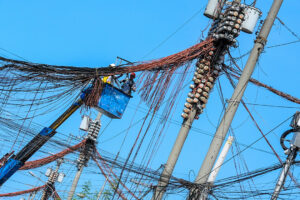ERC rushes power supply deals for electric co-ops

THE ENERGY Regulatory Commission (ERC) is ramping up the approvals of power supply agreements (PSAs) to minimize electric cooperatives’ (co-ops) exposure to the Wholesale Electricity Spot Market (WESM) as the summer season approaches.
“We are rushing all the approvals for power supply agreements for particularly our electric cooperatives that are exposed to WESM,” ERC Chairperson and Chief Executive Officer Monalisa C. Dimalanta told reporters.
“So that even if we’re entering the summer months… even if the WESM prices spike, their consumers can be insulated from the increase because they are charged under the power supply agreements,” she added.
The majority of the power supply deals lined up are for electric cooperatives in the Visayas, she said.
In June last year, the ERC chief said there were many distribution utilities, primarily electric cooperatives, that were nearly fully exposed to the WESM, pending bilateral contracts where the price is locked in.
WESM is where energy companies can purchase power when their long-term contracted power supply is insufficient for customer needs.
Last month, the Independent Electricity Market Operator of the Philippines (IEMOP), the operator of WESM, said that it is projecting an increase in spot market prices due to anticipated higher demand during the dry season.
Ms. Dimalanta said the Department of Energy (DoE) is coordinating with the power generators on the supply situation as it also approves the outage schedules.
“So, from our end, we coordinate with the DoE. The generators notify us if there is any expected maintenance,” she said.
The DoE recently urged Luzon power consumers to conserve energy as South Premiere Power Corp. (SPPC) and Excellent Energy Resources, Inc. (EERI) are scheduled to implement a scheduled shutdown of their gas-fired power plants from March 29 to 31.
“This temporary shutdown is necessary to facilitate mechanical activities at Linseed Field Corp.’s liquefied natural gas (LNG) terminal, a crucial step towards completing its first onshore LNG storage tank by the end of April this year,” the DoE said in a statement on Friday.
SPPC and EERI are jointly owned by Meralco PowerGen Corp. of Manila Electric Co., Therma NatGas Power, Inc. of Aboitiz Power Corp., and San Miguel Global Power Holdings Corp. of San Miguel Corp. These firms earlier this year sealed a $3.3-billion LNG deal to launch the country’s first LNG facility.
The DoE said the shutdown of the plants was strategically planned in coordination with the National Grid Corp. of the Philippines “to coincide with lower system demand, minimizing potential supply disruptions.”
No yellow or red alerts are expected during the period but a temporary increase in spot market prices could happen, according to the initial assessment of the IEMOP.
GREEN ENERGY AUCTION
Meanwhile, Ms. Dimalanta said that the ERC is drafting the proposed ceiling prices for the upcoming fourth round of green energy auction (GEA-4) this year.
“We are in the process of putting together the GEA-4 rates for public consultation so that we can set the GEAR (green energy auction reserve) price… We’ve had a lot of FGDs (focus group discussions) conducted already with the developers. And I think we are more aligned now in terms of the assumptions and expectations,” she said.
The ERC determines the GEAR prices, or the maximum price in peso per kilowatt-hour that will serve as the ceiling price in the auctions.
Under GEA-4, the DoE is set to auction off a total of 10,478 megawatts (MW) of renewable energy (RE) capacity, which includes some that will be paired with battery energy storage systems.
The government is planning to offer 3,940 MW of ground-mounted solar capacity, 48 MW of roof-mounted solar capacity, 3,000 MW of floating solar capacity, and 2,390 MW of onshore wind capacity.
Under the program’s setup, interested RE producers compete for incentivized fixed power rates by offering their lowest price for a certain capacity set by the ERC. — Sheldeen Joy Talavera











